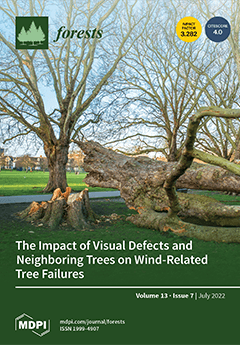Pitch pine (
Pinus rigida Mill.) is native to North America and has a strong resistance to pine wood nematodes (PWNs). The PWN resistance mechanism of this tree species has yet to be discovered. In this work, we found that the spreading of inoculated PWNs in the branch of
P. rigida was significantly suppressed compared to those in the branches of
Pinus densiflora (Sieb. et Zucc.) and
Pinus koraiensis (Sieb. et Zucc.). Dipping of PWNs in the resins isolated from
P. rigida significantly suppressed the PWN mobility and conferred significantly higher PWN mortality compared to those in the resins from
P. densiflora and
P. koraiensis. All PWNs dipped in
P. rigida resin were killed after six days, but more than 50% of the PWNs dipped in the resin from
P. densiflora, and
P. koraiensis were still alive after six days. The phytochemical analysis of resins revealed that
P. rigida resin contained little or no amount of sesquiterpenes compared to those from
P. densiflora and
P. koraiensis. However,
P. rigida resin contained rich amounts of diterpenes, among which dehydroabietic aldehyde, methyl dehydroabietate, and methyl abietate were uniquely detected. Particularly, two pinosylvin stilbenes (
trans and
cis-3,5-dimethoxystilbene) were accumulated in
P. rigida resin, which were not detected in the resins from
P. densiflora and
P. koraiensis. cis-3,5-Dimethoxystilbene showed high nematicidal activity but not in
trans-3,5-dimethoxystilbene. Conclusively, PWN resistance of
P. rigida may be due to the toxic chemicals in the resin, in which
cis-3,5-dimethoxystilbene may contribute to PWN toxicity. This work is the first demonstration that resin from PWN-resistant
P. rigida directly affected PWN mobility and mortality, probably due to toxic phytochemicals in the resin.
Full article





